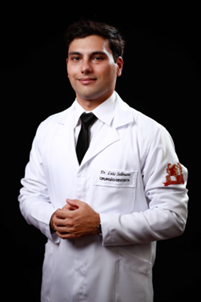AUCTORES
Globalize your Research
Short Communication | DOI: https://doi.org/10.31579/2690-8808/249
*Corresponding Author: I. Klepikov MD. Professor (retired), Renton, WA. USA.
Citation: I. Klepikov, (2025), What does the time Factor Teach us in Severe Pneumonia?, J, Clinical Case Reports and Studies, 6(3); DOI:10.31579/2690-8808/249
Copyright: ©, 2025, I. Klepikov. This is an open access article distributed under the Creative Commons Attribution License, which permits unrestricted use, distribution, and reproduction in any medium, provided the original work is properly cited.
Received: 12 March 2025 | Accepted: 20 March 2025 | Published: 27 March 2025
Keywords: pneumonia; diagnostics of AP pathogens; Infusion therapy
Acute nonspecific inflammation of the lungs (ANSIL) is a prototype of such a nosology as acute pneumonia (AP), which has been known to medicine since ancient times [1]. Despite such a long period of its fame, AP remains an inflammatory disease that is difficult to treat and is one of the problems of global health, being among the leaders in mortality rates in recent years [2-4].
1. Acute nonspecific inflammation of the lungs (ANSIL) is a prototype of such a nosology as acute pneumonia (AP), which has been known to medicine since ancient times [1]. Despite such a long period of its fame, AP remains an inflammatory disease that is difficult to treat and is one of the problems of global health, being among the leaders in mortality rates in recent years [2-4].
2. The development of microbiology in the late 19th and early 20th centuries contributed to the emergence of the so-called microbial theory of the development of AP [5], which, with the advent of antibiotics in clinical practice, not only strengthened, but also, despite numerous facts of contradictions and inconsistencies, completely took over professional ideas about the nature of the disease, turning into the dominant teaching. At present, the main cause of AP remains its pathogen, and the main means of hope for successful treatment are considered to be etiotropic drugs, among which, despite obvious changes in the etiology of the disease, antibiotics continue to play the main role.
3. With the advent of antibiotics in medical practice, it became known that their therapeutic capabilities are limited only by the antimicrobial effect, which in turn is selective in nature depending on the type of drug. There was and is no evidence that antibiotics can have a direct (!) effect on the mechanisms of the inflammatory process itself and its consequences so that this effect would immediately be reflected in clinical manifestations. Therefore, the action of antibiotics consists exclusively in the indirect fulfillment of their role. Neutralizing one of the integral factors of non-specific inflammation, they make it easier for the body to independently eliminate a sudden catastrophe, right?
4. In the era of antibiotics, there was a fairly long period when the principle of treating inflammatory processes "antibiotics alone", including AP, was quite satisfactory in its results. The gradual and natural decrease in the sensitivity of microbes to such drugs and the change in the list of AP pathogens increasingly required the use of additional and supportive therapy, which was a serious sign for a radical revision of the disease management strategy. However, medicine has been striving for many years to revive the former effectiveness of this therapy and, in particular, to achieve the earliest possible determination of the pathogen in order to prescribe targeted antimicrobial therapy. In this case, various methods were used to obtain material for early microbiological diagnostics, including even such traumatic and poorly substantiated options as transthoracic puncture of the lung [6] and even open organ biopsy [7].
5. It is noteworthy that attempts to achieve the possibility of differential diagnostics of AP by etiological sign have not been successful not only among bacterial inflammations, but also for distinguishing bacterial and viral forms of the disease in everyday practice [8-10]. A very indicative result of the failure of many years of attempts to determine the etiology of AP has been the recognition in recent years at the level of leading world forums on this problem of the empirical prescription of antibiotics as the main principle of antimicrobial therapy [11-12].
6. Attempts to master early diagnostics of AP pathogens have been going on for decades, without achieving the set goals and expected results. Moreover, in recent years, a clear increase in the proportion of viral forms of the disease and an increase in the number of negative results of microbiological diagnostics, exceeding half of the studies [13], make the previously stated goals even more distant and illusory. However, more and more new efforts in this direction continue to this day, striking in their obsession and blind faith in the decisive role of antibiotics [14-16]. At the same time, even after many decades, antibiotics continue to be unshakably considered a means of first and emergency aid for AP [15-18].
7. Today, continuing to rely on the effect of rapid empirical use of antibiotics in patients with AP, specialists know that the early terms of evaluation of the result are usually from 48 to 72 hours [11,12]. In the case of aggressive development of the inflammatory process, waiting for an indirect result of antimicrobial drugs for 2-3 days for many patients plays a tragic role in the further development of events. In this regard, it should be noted that the condition of many patients, which did not inspire concern at the time of hospitalization in general departments, already in the first two days after the start of treatment requires their urgent transfer to intensive care units (ICU)due to the observed deterioration of the condition [19]. Li Jianping et al. [20] note that many fatal cases occur in the first 48-72 hours after the start of treatment.
8. The antimicrobial strategy for treating AP began to form literally on the eve of the advent of antibiotics, when practical medicine was able to use sulfonamides and antipneumococcal antiserum [5]. Therefore, the psychological atmosphere was already prepared for the appearance of the first results of antibiotic therapy, and this therapy began to be perceived as the acquisition of a universal remedy for further success in the treatment of bacterial inflammatory processes. Over time, the leading role assigned to it in the treatment of AP looked increasingly dubious against the background of the accumulation of contradictory facts. However, this point of view continued and continues to dominate, remaining a generally accepted practical guide. More than one generation of doctors has been brought up on the dominance of these principles, who are steadfastly guided by etiotropic approaches to the treatment of AP.
9. Over time, severe forms of AP that were poorly treatable with antimicrobial drugs and required additional and supportive therapy began to be observed more frequently, and the patients themselves were candidates for hospitalization in the intensive care unit. At the same time, the results of treatment of such patients were accompanied by severe complications and high mortality, and the examination data did not confirm the version of the presence of particularly virulent pathogens in them. This contingent began to be considered and analyzed separately in the hope of understanding the reasons for such an aggressive development of the disease [11,12,21-23]. However, the views of specialists, significantly tied to the important role of the pathogen, and not to the pathogenetic influence of the inflammation focus, turned out to be aimed mainly at finding prognostic signs [11,12,21-25]. The very principle of such studies reflects a wait-and-see attitude, demonstrating a certain stage-by-stage provision of assistance as the situation changes.
10. Identification of patients with severe course of the disease at the initial stages of development of AP using prognostic tests does not give the expected results, having quite real grounds. The meaning of such stratification is to identify patients with AP for hospitalization in the intensive care unit, based on the characteristics of treatment in such units. However, the general principles of basic treatment, which are currently applied to all inflammatory processes, regardless of their localization and mechanisms of development, are completely incompatible with the specifics of the pathogenesis of AP. Intensification of such therapy in a more severe category of patients with ANSIL is, in my opinion, one of the main reasons for such a significant difference in mortality rates among hospitalized patients, which in general departments is 5-10%, and in intensive care units reaches 50% or more [26-28].
11. The fact that the arterial pressure in the pulmonary vessels is approximately 8 times lower than in the systemic circulation is known to every specialist [29,30]. It is also known that the two circulations are closely and inextricably linked, maintaining a constant parity of the cardiac output of the two heart ventricles with such opposite indicators and supporting the vital need for synchronous heart function. The mechanisms of such adaptation act automatically, independently of our consciousness, literally ensuring our salvation in the most critical situations. However, in this regard, the logic of modern medical actions in patients with severe AP defies explanation.
12. On the one hand, the inflammatory transformation of tissues is based on a vascular reaction with a pronounced impairment of blood flow and a sharp increase in vascular permeability [31]. On the other hand, unlike all known inflammatory diseases localized in the systemic circulation, only OP is the only nosology that occurs in the vessels of the pulmonary circulation. The pulmonary vessels, through which all circulating blood passes, are equipped with baroreceptors that respond to the slightest fluctuations in arterial pressure and play a critical role in regulating the general blood flow, which was established almost a century ago [32]. It is this mechanism that allows maintaining synchronicity in the work of the two halves of the heart, ensuring unloading of the right chambers of the heart and equalizing proportions with its left half. Unfortunately, this compensatory reaction was only rarely considered in previous years in such extreme situations as, for example, pulmonary embolism or attracted the attention of pathophysiologists [33-36]. In recent years, research on the problem under discussion has been aimed exclusively at studying micromechanisms, rather than integral manifestations of the process.
13. With aggressive development of the inflammatory process in the lung, the body is limited in time for smooth adaptation to new functional conditions. Rapid development of the focus is accompanied by an extreme protective reaction, which is manifested by a generalized spasm of small-diameter pulmonary vessels [37,38], creating a state of relative excess of venous return and overload of the right heart. In such situations in modern medicine, instead of the logically necessary elimination of the pathological mechanism that has arisen, which is the cause of respiratory and circulatory disorders, patients undergo etiotropic therapy, and while waiting for its results, bolus infusions are administered [11,12,15,16,18]. Such medical care is explained by the septic condition of patients, although in reality, the observed disorders are not infectious, but pulmonogenic in nature and can be quickly eliminated [39].
14. Infusion therapy, which in similar situations with other inflammatory processes has a pathogenetically conditioned direction, has a directly opposite effect in AP, stimulating both local and general disorders [39]. The earliest changes in general circulation, when there are no deviations in blood flow indicators, are manifested by signs of microcirculation disorders [40-42]. In this case, widespread disruption of the blood supply to tissue structures is accompanied by a change in metabolism and an increase in the level of various substances. Many of these microfactors are currently used as markers for predicting possible variants of disease development, but, ultimately, these processes manifest themselves in the most vulnerable localizations. Therefore, it is quite natural that the first to show their functional insufficiency are organs that have already been subjected to previous damage and diseases.
15. The most frequent complication in the treatment of AP remains acute respiratory distress syndrome (ARDS), the cause of which should be considered primarily a disturbance of microcirculation in the pulmonary circulation, accompanying severe forms of the disease. Persistent disturbance of the blood supply to the alveolar parts of the lungs is not particularly amenable to currently accepted treatment (etiotropic therapy, intravenous infusions, vasopressors) and, if it persists over time, can only worsen against the background of such therapy, having classic prerequisites for the development of this syndrome. From my point of view, it is easy to understand that the development of ARDS in severe patients with AP is a reflection of the lost time waiting for the effect of antimicrobial therapy and efforts directed against adaptive mechanisms.
16. The occurrence of ARDS syndrome with pronounced disturbances of blood flow in the pulmonary circulation, through which all the blood circulating in the body passes, inevitably leads to profound disturbances of blood circulation in the systemic circulation. In such cases, modern attempts to influence individual links of the neglected process, undertaken today at the cellular and molecular level, are palliative in nature. As the results of such actions show, miracles do not happen and the next stage in most observations is predictably multiple organ failure [21-23,42-44]. If we initially consider the timing of intubation of such patients as strategic (!?) measures [45] and begin to discuss the important role of oxygen delivery methods [46-48] or the urgent need to issue additional artificial lung ventilation devices [49-51], then we must forget about the possibility of achieving success in solving the problem under discussion. The choice of these directions reflects the recognition of the inevitability of the expected results and is devoid of the search for the main causes.
17. If we follow the stages of treatment and analyze the timing of the appearance of the first signs, and sometimes the development of complications themselves in patients with severe forms of AP, then the most significant and fateful period is the first 2-3 days. During this time, the inflammatory process in severe forms of the disease can in some cases progress literally by the hour, and further success will depend on the speed of assistance, and most importantly, on its direction and nature [39]. Stubbornly concentrating on etiotropic approaches to the treatment of AP, modern medicine completely ignores many of its own studies, the results of which show that the etiology of the process does not determine its manifestations and severity, which depend on the functional characteristics of the affected organ [39].
18. The atmosphere of delight and positivity after the first results of antibiotic therapy, which seemed endless to many, has long since evaporated, but incredible attempts to revive this medical direction continue with unabated efforts. All these studies rely only on the latest developments, delving into the molecular-cellular world, through the prism of which doctors try to understand what is happening to the patient. The thousand-year experience of ancient medicine, obtained empirically and continuing to be used in health and rehabilitation complexes, was declared untenable and even quackery by official medicine [52,53]. However, having discarded the previous experience without serious research and having started a new stage virtually from scratch, official medicine has reached a dead end in the problem under discussion, but few specialists are aware of this yet.
19. Contrary to the widespread negative opinion about ancient methods of treatment, modern medicine resorts to some of them in clinical situations. For example, cooling the body of patients is used for some diseases, demonstrating its positive properties [54], but the FDA has not yet approved this type of therapy, requiring more serious evidence [55]. In our previous work, in the treatment of severe forms of AP, we used such a modern method of emergency care as cervical novocaine vagosympathetic blockade (CVSB), as well as such ancient methods as short-term general body cooling of patients (GBC) and cupping therapy (CPT). Modern studies, as a rule, do not provide for an assessment of the direct effect of the studied treatment methods. As a rule, the treatment results are compared between the main and control groups, and it is sometimes difficult to understand what role the tested method played. In contrast to such approaches, we used the registration of comparative rheopulmonograms before and immediately after the procedure, obtaining objective evidence of the real effectiveness of these methods in a short period of time [39].
20. At present, the main hopes for success in the treatment of AP continue to be placed on antibacterial therapy, the assessment of the result of which is usually expected in 2-3 days. At this time, the supply of oxygen to seriously ill patients, as is known, does not make any decisive changes in the dynamics of the process, performing a supporting and auxiliary function. Emergency infusions in such patients give the opposite effect. The question naturally arises - what first and emergency aid for the most seriously ill patients can quickly and noticeably alleviate their condition? It remains to be noted that today in the arsenal of medicine there are no options for such emergency aid, capable of invariably and immediately making significant positive changes in the condition of patients with AP in the initial period of the disease.
21. In the 1930s, antipneumococcal antiserum was successfully used in the treatment of patients with AP, the effect of which was viewed in terms of its emergency administration after results confirming the pneumococcal etiology of the inflammation [5]. To optimize this care, a large network of microbiological diagnostic laboratories was created in the United States, operating around the clock, and the urgency of the clinical situation for pneumonia was compared with the need for emergency care for acute appendicitis [5]. The organization of this system of care for patients with AP was dismantled after the advent of antibiotics, the early results of which created the illusion of faith in their exceptional curative power. This belief system continues to dominate professional thinking despite the changes that have occurred over more than eight decades.
22. As a result of the above analysis of data on the modern complex of medical care for patients with AP, one can note the clearly protracted, but not capable of having a real impact on the dynamics of the inflammatory process, dominance of a narrowly focused etiotropic approach. Attempts by a number of specialists to explain the "undoubted effectiveness" of antibacterial therapy in the majority of patients with AP, "successfully treated" in outpatient settings [4], is a purely statistical declaration. Compare these data with the results of observations of patients with inflammatory processes of coronavirus etiology during the SARS-CoV-2 pandemic, when patients found themselves without specific etiotropic therapy, and you will not see a significant statistical difference between the groups of patients - those who fell ill but recovered on an outpatient basis, and those hospitalized [56,57]. This suggests that similar processes of the same localization develop according to a single scenario, differing only in the rate of their spread and the level of adaptability for the host organism.
23. The absence of pathogenetically substantiated first and emergency care for patients with AP is the reason for the loss of precious time in the initial period of the disease, which allows the neglected mechanisms to progress. Without changing the basic principles of treatment of this category of patients and without trying to radically revise existing ideas, modern medicine is trying to improve etiotropic methods of treatment, while simultaneously searching for tests that allow predicting the likelihood of complications of the process and fatal outcomes. The latter trend reflects the absence of signs of a new ideology in modern research on the problem under discussion and the actual capitulation to the current circumstances. It is easy to understand that all these misconceptions are based on the mental legacy of many years of veneration of antibiotics, which is the first and inevitable factor that requires elimination.
This Manuscript is a full initiative of the author and does not have any funding.
The author states that he has no conflict of interest.
Clearly Auctoresonline and particularly Psychology and Mental Health Care Journal is dedicated to improving health care services for individuals and populations. The editorial boards' ability to efficiently recognize and share the global importance of health literacy with a variety of stakeholders. Auctoresonline publishing platform can be used to facilitate of optimal client-based services and should be added to health care professionals' repertoire of evidence-based health care resources.

Journal of Clinical Cardiology and Cardiovascular Intervention The submission and review process was adequate. However I think that the publication total value should have been enlightened in early fases. Thank you for all.

Journal of Women Health Care and Issues By the present mail, I want to say thank to you and tour colleagues for facilitating my published article. Specially thank you for the peer review process, support from the editorial office. I appreciate positively the quality of your journal.
Journal of Clinical Research and Reports I would be very delighted to submit my testimonial regarding the reviewer board and the editorial office. The reviewer board were accurate and helpful regarding any modifications for my manuscript. And the editorial office were very helpful and supportive in contacting and monitoring with any update and offering help. It was my pleasure to contribute with your promising Journal and I am looking forward for more collaboration.

We would like to thank the Journal of Thoracic Disease and Cardiothoracic Surgery because of the services they provided us for our articles. The peer-review process was done in a very excellent time manner, and the opinions of the reviewers helped us to improve our manuscript further. The editorial office had an outstanding correspondence with us and guided us in many ways. During a hard time of the pandemic that is affecting every one of us tremendously, the editorial office helped us make everything easier for publishing scientific work. Hope for a more scientific relationship with your Journal.

The peer-review process which consisted high quality queries on the paper. I did answer six reviewers’ questions and comments before the paper was accepted. The support from the editorial office is excellent.

Journal of Neuroscience and Neurological Surgery. I had the experience of publishing a research article recently. The whole process was simple from submission to publication. The reviewers made specific and valuable recommendations and corrections that improved the quality of my publication. I strongly recommend this Journal.

Dr. Katarzyna Byczkowska My testimonial covering: "The peer review process is quick and effective. The support from the editorial office is very professional and friendly. Quality of the Clinical Cardiology and Cardiovascular Interventions is scientific and publishes ground-breaking research on cardiology that is useful for other professionals in the field.

Thank you most sincerely, with regard to the support you have given in relation to the reviewing process and the processing of my article entitled "Large Cell Neuroendocrine Carcinoma of The Prostate Gland: A Review and Update" for publication in your esteemed Journal, Journal of Cancer Research and Cellular Therapeutics". The editorial team has been very supportive.

Testimony of Journal of Clinical Otorhinolaryngology: work with your Reviews has been a educational and constructive experience. The editorial office were very helpful and supportive. It was a pleasure to contribute to your Journal.

Dr. Bernard Terkimbi Utoo, I am happy to publish my scientific work in Journal of Women Health Care and Issues (JWHCI). The manuscript submission was seamless and peer review process was top notch. I was amazed that 4 reviewers worked on the manuscript which made it a highly technical, standard and excellent quality paper. I appreciate the format and consideration for the APC as well as the speed of publication. It is my pleasure to continue with this scientific relationship with the esteem JWHCI.

This is an acknowledgment for peer reviewers, editorial board of Journal of Clinical Research and Reports. They show a lot of consideration for us as publishers for our research article “Evaluation of the different factors associated with side effects of COVID-19 vaccination on medical students, Mutah university, Al-Karak, Jordan”, in a very professional and easy way. This journal is one of outstanding medical journal.
Dear Hao Jiang, to Journal of Nutrition and Food Processing We greatly appreciate the efficient, professional and rapid processing of our paper by your team. If there is anything else we should do, please do not hesitate to let us know. On behalf of my co-authors, we would like to express our great appreciation to editor and reviewers.

As an author who has recently published in the journal "Brain and Neurological Disorders". I am delighted to provide a testimonial on the peer review process, editorial office support, and the overall quality of the journal. The peer review process at Brain and Neurological Disorders is rigorous and meticulous, ensuring that only high-quality, evidence-based research is published. The reviewers are experts in their fields, and their comments and suggestions were constructive and helped improve the quality of my manuscript. The review process was timely and efficient, with clear communication from the editorial office at each stage. The support from the editorial office was exceptional throughout the entire process. The editorial staff was responsive, professional, and always willing to help. They provided valuable guidance on formatting, structure, and ethical considerations, making the submission process seamless. Moreover, they kept me informed about the status of my manuscript and provided timely updates, which made the process less stressful. The journal Brain and Neurological Disorders is of the highest quality, with a strong focus on publishing cutting-edge research in the field of neurology. The articles published in this journal are well-researched, rigorously peer-reviewed, and written by experts in the field. The journal maintains high standards, ensuring that readers are provided with the most up-to-date and reliable information on brain and neurological disorders. In conclusion, I had a wonderful experience publishing in Brain and Neurological Disorders. The peer review process was thorough, the editorial office provided exceptional support, and the journal's quality is second to none. I would highly recommend this journal to any researcher working in the field of neurology and brain disorders.

Dear Agrippa Hilda, Journal of Neuroscience and Neurological Surgery, Editorial Coordinator, I trust this message finds you well. I want to extend my appreciation for considering my article for publication in your esteemed journal. I am pleased to provide a testimonial regarding the peer review process and the support received from your editorial office. The peer review process for my paper was carried out in a highly professional and thorough manner. The feedback and comments provided by the authors were constructive and very useful in improving the quality of the manuscript. This rigorous assessment process undoubtedly contributes to the high standards maintained by your journal.

International Journal of Clinical Case Reports and Reviews. I strongly recommend to consider submitting your work to this high-quality journal. The support and availability of the Editorial staff is outstanding and the review process was both efficient and rigorous.

Thank you very much for publishing my Research Article titled “Comparing Treatment Outcome Of Allergic Rhinitis Patients After Using Fluticasone Nasal Spray And Nasal Douching" in the Journal of Clinical Otorhinolaryngology. As Medical Professionals we are immensely benefited from study of various informative Articles and Papers published in this high quality Journal. I look forward to enriching my knowledge by regular study of the Journal and contribute my future work in the field of ENT through the Journal for use by the medical fraternity. The support from the Editorial office was excellent and very prompt. I also welcome the comments received from the readers of my Research Article.

Dear Erica Kelsey, Editorial Coordinator of Cancer Research and Cellular Therapeutics Our team is very satisfied with the processing of our paper by your journal. That was fast, efficient, rigorous, but without unnecessary complications. We appreciated the very short time between the submission of the paper and its publication on line on your site.

I am very glad to say that the peer review process is very successful and fast and support from the Editorial Office. Therefore, I would like to continue our scientific relationship for a long time. And I especially thank you for your kindly attention towards my article. Have a good day!

"We recently published an article entitled “Influence of beta-Cyclodextrins upon the Degradation of Carbofuran Derivatives under Alkaline Conditions" in the Journal of “Pesticides and Biofertilizers” to show that the cyclodextrins protect the carbamates increasing their half-life time in the presence of basic conditions This will be very helpful to understand carbofuran behaviour in the analytical, agro-environmental and food areas. We greatly appreciated the interaction with the editor and the editorial team; we were particularly well accompanied during the course of the revision process, since all various steps towards publication were short and without delay".

I would like to express my gratitude towards you process of article review and submission. I found this to be very fair and expedient. Your follow up has been excellent. I have many publications in national and international journal and your process has been one of the best so far. Keep up the great work.

We are grateful for this opportunity to provide a glowing recommendation to the Journal of Psychiatry and Psychotherapy. We found that the editorial team were very supportive, helpful, kept us abreast of timelines and over all very professional in nature. The peer review process was rigorous, efficient and constructive that really enhanced our article submission. The experience with this journal remains one of our best ever and we look forward to providing future submissions in the near future.

I am very pleased to serve as EBM of the journal, I hope many years of my experience in stem cells can help the journal from one way or another. As we know, stem cells hold great potential for regenerative medicine, which are mostly used to promote the repair response of diseased, dysfunctional or injured tissue using stem cells or their derivatives. I think Stem Cell Research and Therapeutics International is a great platform to publish and share the understanding towards the biology and translational or clinical application of stem cells.

I would like to give my testimony in the support I have got by the peer review process and to support the editorial office where they were of asset to support young author like me to be encouraged to publish their work in your respected journal and globalize and share knowledge across the globe. I really give my great gratitude to your journal and the peer review including the editorial office.

I am delighted to publish our manuscript entitled "A Perspective on Cocaine Induced Stroke - Its Mechanisms and Management" in the Journal of Neuroscience and Neurological Surgery. The peer review process, support from the editorial office, and quality of the journal are excellent. The manuscripts published are of high quality and of excellent scientific value. I recommend this journal very much to colleagues.

Dr.Tania Muñoz, My experience as researcher and author of a review article in The Journal Clinical Cardiology and Interventions has been very enriching and stimulating. The editorial team is excellent, performs its work with absolute responsibility and delivery. They are proactive, dynamic and receptive to all proposals. Supporting at all times the vast universe of authors who choose them as an option for publication. The team of review specialists, members of the editorial board, are brilliant professionals, with remarkable performance in medical research and scientific methodology. Together they form a frontline team that consolidates the JCCI as a magnificent option for the publication and review of high-level medical articles and broad collective interest. I am honored to be able to share my review article and open to receive all your comments.

“The peer review process of JPMHC is quick and effective. Authors are benefited by good and professional reviewers with huge experience in the field of psychology and mental health. The support from the editorial office is very professional. People to contact to are friendly and happy to help and assist any query authors might have. Quality of the Journal is scientific and publishes ground-breaking research on mental health that is useful for other professionals in the field”.

Dear editorial department: On behalf of our team, I hereby certify the reliability and superiority of the International Journal of Clinical Case Reports and Reviews in the peer review process, editorial support, and journal quality. Firstly, the peer review process of the International Journal of Clinical Case Reports and Reviews is rigorous, fair, transparent, fast, and of high quality. The editorial department invites experts from relevant fields as anonymous reviewers to review all submitted manuscripts. These experts have rich academic backgrounds and experience, and can accurately evaluate the academic quality, originality, and suitability of manuscripts. The editorial department is committed to ensuring the rigor of the peer review process, while also making every effort to ensure a fast review cycle to meet the needs of authors and the academic community. Secondly, the editorial team of the International Journal of Clinical Case Reports and Reviews is composed of a group of senior scholars and professionals with rich experience and professional knowledge in related fields. The editorial department is committed to assisting authors in improving their manuscripts, ensuring their academic accuracy, clarity, and completeness. Editors actively collaborate with authors, providing useful suggestions and feedback to promote the improvement and development of the manuscript. We believe that the support of the editorial department is one of the key factors in ensuring the quality of the journal. Finally, the International Journal of Clinical Case Reports and Reviews is renowned for its high- quality articles and strict academic standards. The editorial department is committed to publishing innovative and academically valuable research results to promote the development and progress of related fields. The International Journal of Clinical Case Reports and Reviews is reasonably priced and ensures excellent service and quality ratio, allowing authors to obtain high-level academic publishing opportunities in an affordable manner. I hereby solemnly declare that the International Journal of Clinical Case Reports and Reviews has a high level of credibility and superiority in terms of peer review process, editorial support, reasonable fees, and journal quality. Sincerely, Rui Tao.

Clinical Cardiology and Cardiovascular Interventions I testity the covering of the peer review process, support from the editorial office, and quality of the journal.

Clinical Cardiology and Cardiovascular Interventions, we deeply appreciate the interest shown in our work and its publication. It has been a true pleasure to collaborate with you. The peer review process, as well as the support provided by the editorial office, have been exceptional, and the quality of the journal is very high, which was a determining factor in our decision to publish with you.
The peer reviewers process is quick and effective, the supports from editorial office is excellent, the quality of journal is high. I would like to collabroate with Internatioanl journal of Clinical Case Reports and Reviews journal clinically in the future time.

Clinical Cardiology and Cardiovascular Interventions, I would like to express my sincerest gratitude for the trust placed in our team for the publication in your journal. It has been a true pleasure to collaborate with you on this project. I am pleased to inform you that both the peer review process and the attention from the editorial coordination have been excellent. Your team has worked with dedication and professionalism to ensure that your publication meets the highest standards of quality. We are confident that this collaboration will result in mutual success, and we are eager to see the fruits of this shared effort.

Dear Dr. Jessica Magne, Editorial Coordinator 0f Clinical Cardiology and Cardiovascular Interventions, I hope this message finds you well. I want to express my utmost gratitude for your excellent work and for the dedication and speed in the publication process of my article titled "Navigating Innovation: Qualitative Insights on Using Technology for Health Education in Acute Coronary Syndrome Patients." I am very satisfied with the peer review process, the support from the editorial office, and the quality of the journal. I hope we can maintain our scientific relationship in the long term.
Dear Monica Gissare, - Editorial Coordinator of Nutrition and Food Processing. ¨My testimony with you is truly professional, with a positive response regarding the follow-up of the article and its review, you took into account my qualities and the importance of the topic¨.

Dear Dr. Jessica Magne, Editorial Coordinator 0f Clinical Cardiology and Cardiovascular Interventions, The review process for the article “The Handling of Anti-aggregants and Anticoagulants in the Oncologic Heart Patient Submitted to Surgery” was extremely rigorous and detailed. From the initial submission to the final acceptance, the editorial team at the “Journal of Clinical Cardiology and Cardiovascular Interventions” demonstrated a high level of professionalism and dedication. The reviewers provided constructive and detailed feedback, which was essential for improving the quality of our work. Communication was always clear and efficient, ensuring that all our questions were promptly addressed. The quality of the “Journal of Clinical Cardiology and Cardiovascular Interventions” is undeniable. It is a peer-reviewed, open-access publication dedicated exclusively to disseminating high-quality research in the field of clinical cardiology and cardiovascular interventions. The journal's impact factor is currently under evaluation, and it is indexed in reputable databases, which further reinforces its credibility and relevance in the scientific field. I highly recommend this journal to researchers looking for a reputable platform to publish their studies.

Dear Editorial Coordinator of the Journal of Nutrition and Food Processing! "I would like to thank the Journal of Nutrition and Food Processing for including and publishing my article. The peer review process was very quick, movement and precise. The Editorial Board has done an extremely conscientious job with much help, valuable comments and advices. I find the journal very valuable from a professional point of view, thank you very much for allowing me to be part of it and I would like to participate in the future!”

Dealing with The Journal of Neurology and Neurological Surgery was very smooth and comprehensive. The office staff took time to address my needs and the response from editors and the office was prompt and fair. I certainly hope to publish with this journal again.Their professionalism is apparent and more than satisfactory. Susan Weiner

My Testimonial Covering as fellowing: Lin-Show Chin. The peer reviewers process is quick and effective, the supports from editorial office is excellent, the quality of journal is high. I would like to collabroate with Internatioanl journal of Clinical Case Reports and Reviews.

My experience publishing in Psychology and Mental Health Care was exceptional. The peer review process was rigorous and constructive, with reviewers providing valuable insights that helped enhance the quality of our work. The editorial team was highly supportive and responsive, making the submission process smooth and efficient. The journal's commitment to high standards and academic rigor makes it a respected platform for quality research. I am grateful for the opportunity to publish in such a reputable journal.
My experience publishing in International Journal of Clinical Case Reports and Reviews was exceptional. I Come forth to Provide a Testimonial Covering the Peer Review Process and the editorial office for the Professional and Impartial Evaluation of the Manuscript.

I would like to offer my testimony in the support. I have received through the peer review process and support the editorial office where they are to support young authors like me, encourage them to publish their work in your esteemed journals, and globalize and share knowledge globally. I really appreciate your journal, peer review, and editorial office.
Dear Agrippa Hilda- Editorial Coordinator of Journal of Neuroscience and Neurological Surgery, "The peer review process was very quick and of high quality, which can also be seen in the articles in the journal. The collaboration with the editorial office was very good."

I would like to express my sincere gratitude for the support and efficiency provided by the editorial office throughout the publication process of my article, “Delayed Vulvar Metastases from Rectal Carcinoma: A Case Report.” I greatly appreciate the assistance and guidance I received from your team, which made the entire process smooth and efficient. The peer review process was thorough and constructive, contributing to the overall quality of the final article. I am very grateful for the high level of professionalism and commitment shown by the editorial staff, and I look forward to maintaining a long-term collaboration with the International Journal of Clinical Case Reports and Reviews.
To Dear Erin Aust, I would like to express my heartfelt appreciation for the opportunity to have my work published in this esteemed journal. The entire publication process was smooth and well-organized, and I am extremely satisfied with the final result. The Editorial Team demonstrated the utmost professionalism, providing prompt and insightful feedback throughout the review process. Their clear communication and constructive suggestions were invaluable in enhancing my manuscript, and their meticulous attention to detail and dedication to quality are truly commendable. Additionally, the support from the Editorial Office was exceptional. From the initial submission to the final publication, I was guided through every step of the process with great care and professionalism. The team's responsiveness and assistance made the entire experience both easy and stress-free. I am also deeply impressed by the quality and reputation of the journal. It is an honor to have my research featured in such a respected publication, and I am confident that it will make a meaningful contribution to the field.

"I am grateful for the opportunity of contributing to [International Journal of Clinical Case Reports and Reviews] and for the rigorous review process that enhances the quality of research published in your esteemed journal. I sincerely appreciate the time and effort of your team who have dedicatedly helped me in improvising changes and modifying my manuscript. The insightful comments and constructive feedback provided have been invaluable in refining and strengthening my work".

I thank the ‘Journal of Clinical Research and Reports’ for accepting this article for publication. This is a rigorously peer reviewed journal which is on all major global scientific data bases. I note the review process was prompt, thorough and professionally critical. It gave us an insight into a number of important scientific/statistical issues. The review prompted us to review the relevant literature again and look at the limitations of the study. The peer reviewers were open, clear in the instructions and the editorial team was very prompt in their communication. This journal certainly publishes quality research articles. I would recommend the journal for any future publications.

Dear Jessica Magne, with gratitude for the joint work. Fast process of receiving and processing the submitted scientific materials in “Clinical Cardiology and Cardiovascular Interventions”. High level of competence of the editors with clear and correct recommendations and ideas for enriching the article.

We found the peer review process quick and positive in its input. The support from the editorial officer has been very agile, always with the intention of improving the article and taking into account our subsequent corrections.

My article, titled 'No Way Out of the Smartphone Epidemic Without Considering the Insights of Brain Research,' has been republished in the International Journal of Clinical Case Reports and Reviews. The review process was seamless and professional, with the editors being both friendly and supportive. I am deeply grateful for their efforts.
To Dear Erin Aust – Editorial Coordinator of Journal of General Medicine and Clinical Practice! I declare that I am absolutely satisfied with your work carried out with great competence in following the manuscript during the various stages from its receipt, during the revision process to the final acceptance for publication. Thank Prof. Elvira Farina

Dear Jessica, and the super professional team of the ‘Clinical Cardiology and Cardiovascular Interventions’ I am sincerely grateful to the coordinated work of the journal team for the no problem with the submission of my manuscript: “Cardiometabolic Disorders in A Pregnant Woman with Severe Preeclampsia on the Background of Morbid Obesity (Case Report).” The review process by 5 experts was fast, and the comments were professional, which made it more specific and academic, and the process of publication and presentation of the article was excellent. I recommend that my colleagues publish articles in this journal, and I am interested in further scientific cooperation. Sincerely and best wishes, Dr. Oleg Golyanovskiy.

Dear Ashley Rosa, Editorial Coordinator of the journal - Psychology and Mental Health Care. " The process of obtaining publication of my article in the Psychology and Mental Health Journal was positive in all areas. The peer review process resulted in a number of valuable comments, the editorial process was collaborative and timely, and the quality of this journal has been quickly noticed, resulting in alternative journals contacting me to publish with them." Warm regards, Susan Anne Smith, PhD. Australian Breastfeeding Association.
